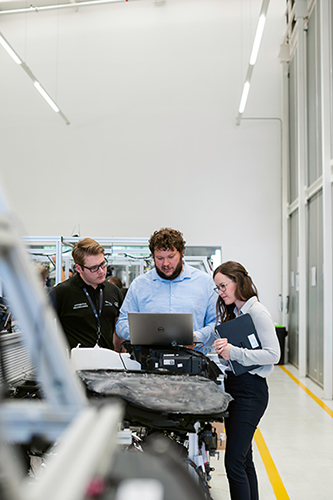A dual sided approach to mitigating labor shortages in the manufacturing industry through AI and recruitment and retention strategies.
By Jacob Olson, Director of Solutions, Cleo
In the coming decade, the United States will experience a long-term shortage of labor, due to low birth rates, baby boomer retirees and shifting immigration policies. Certain economic sectors are more susceptible to the risks of labor shortages than others and should take proactive steps to prepare for the potential impact on productivity. For example, a study examining the manufacturing industry concluded that by 2030 the industry will suffer a projected 2.1 million unfilled jobs brought on by a lack of skilled labor. This means manufacturers must fortify operations and invest in solutions to mitigate the impact of labor shortages. Experts recommend organizations design a two-pronged approach of harvesting a new pipeline of workers and shifting manufacturing processes to support artificial intelligence (AI) in order to increase productivity.
While the demographic labor trends in the United States and the AI revolution are not causally linked, one may provide a counter-balancing effect to the other in the long term. The acceleration of AI adoption in manufacturing is expected to rise substantially in the next few years, with reports indicating that 96% of organizations predict an increase in AI usage and adoption by 2030. Though AI cannot replace the work of humans, it can be used to supplement repetitive, predictive tasks which can reduce errors, increase productivity and improve quality.
The automation of tasks, analysis of data, quality control and predictive maintenance through AI are all highly valuable and accelerate the production of manufacturing while addressing labor concerns. AI powered machinery can supplement repetitive, manual tasks, allowing human workers to focus on more complex responsibilities. The benefits of AI include quality control and defect detection, a once manual process, that can increase in efficiency due to this technology. AI can improve productivity by acting as a co-pilot, optimizing processes, reducing downtime and continually identifying areas of improvement. This technology is already capable of assisting and supercharging workers’ day-to-day activities, as well as analyzing vast amounts of information to identify patterns and help organizations make better informed decisions, such as predicting demand forecasting to optimize inventory.

Not only can AI assist in automation of tasks and operations but it can assist in the recruitment and retention of employees. Developing a robust talent strategy by prioritizing digital fluency and problem-solving skills to adapt to today’s technology creates a healthy workforce. Organizations will need to invest in education and training programs to aid staff in adapting to changing demands of the workplace. Offering this resource provides upskilling opportunities for current and future employees.
The second factor in this equation is increasing the perceived desirability of manufacturing jobs. AI and increased digital literacy in a workplace can aid in the attracting and retaining of talent. A recent analysis of the American workforce found that 92% of jobs require digital skills, yet only one third of workers maintain the foundational digital skills needed to quality for such roles. However, research also proves that shifting from a job requiring no digital skills to one requiring at least three digital skills can increase pay by an average of 45%. Emphasizing the benefits of shifting roles may motivate employees to invest in the benefits of AI and envision themselves as caretakers of this technology to improve quality and efficiency in the long term. As companies increase technological fluency, they will likely be saddled with an influx of applications for positions specific to operations, technical and management responsibilities. As the use of AI increases in manufacturing, positions which oversee the implementation, guidance and success of this technology will likely increase.
While many have warned of job security concerns posed by AI, threatening that it may push human labor out of manufacturing, these trends support the opposite. Evidence suggests that people are not being expunged from manufacturing by AI and digital transformation. Rather, the absence of labor is encouraging optimization of automated, intelligence-driven tasks, and guiding manufacturing labor to master new skills allowing them to take on advanced roles and responsibilities. A recent survey found that 60% of respondents still predict that people will continue to play a key role in manufacturing activities in the future. Though responsibilities may change, humans are still a critical piece of the puzzle in the manufacturing industry and through their guidance, AI will mitigate labor shortages while improving quality and productivity. Through the integration of AI in manufacturing, the workforce is presented with an opportunity to harness new skills, expand their knowledge base, and potentially further their career all while improving operations and automation with the assistance of this technology.

Jacob Olson is Director, Solutions at Cleo, the pioneer and global leader of the Ecosystem Integration software category. Jacob leads Cleo’s Pre-Sales Solutions organization and is responsible for Supply Chain market intelligence. He has over 15 years of experience in Supply Chain integration solutions and has deep expertise in technical sales, pre-sales, product management, and industry analysis. He holds a Bachelor of Science in Computer Science from the University of Wisconsin-Milwaukee.
In this episode, I sat down with Beejan Giga, Director | Partner and Caleb Emerson, Senior Results Manager at Carpedia International. We discussed the insights behind their recent Industry Today article, “Thinking Three Moves Ahead” and together we explored how manufacturers can plan more strategically, align with their suppliers, and build the operational discipline needed to support intentional, sustainable growth. It was a conversation packed with practical perspectives on navigating a fast-changing industry landscape.